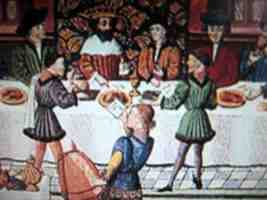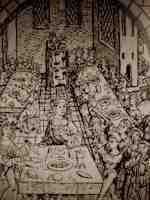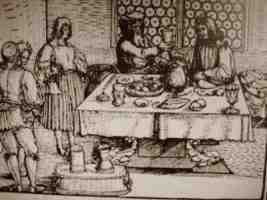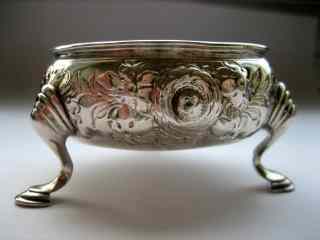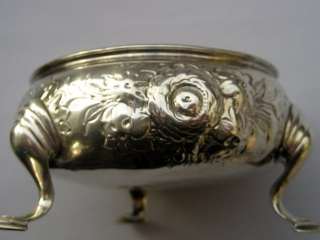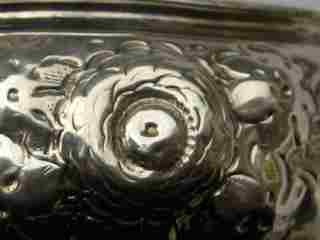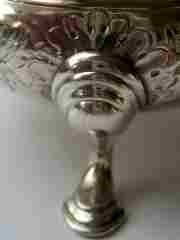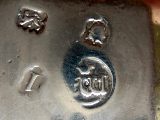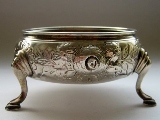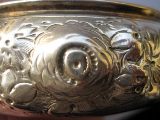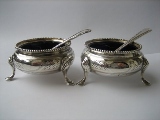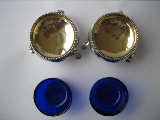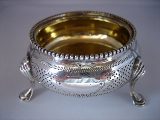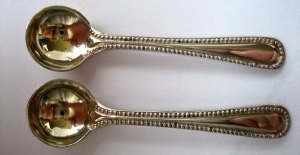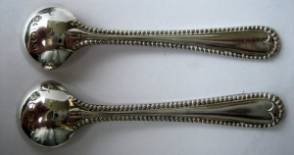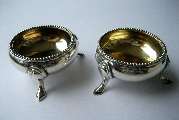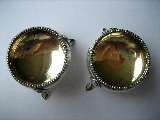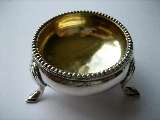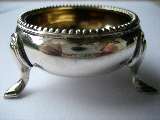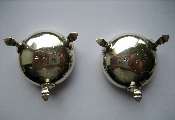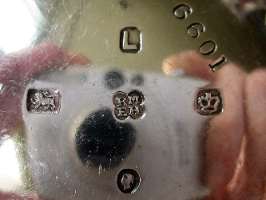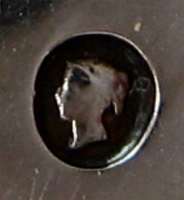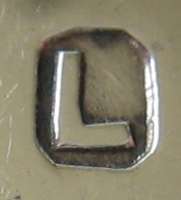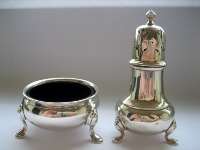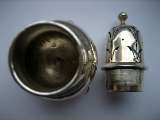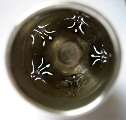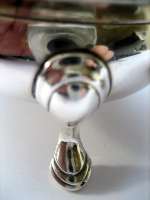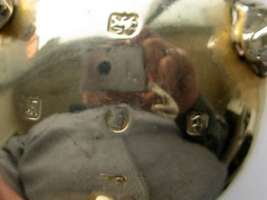by Robert
Massart
|
click on images to enlarge
THREE CENTURIES OF CAULDRON SALTS
HISTORY
At the beginning of the Middle Ages Anglo-Saxons started
to develop table manners in old England. The table setting for a
guest consisted of a trencher, a pointed knife and a
spoon.
Trenchers were made of hard bread (later of wood) and eaten as
part of the meal, given to the poor, or tossed to dogs. Changing
habits and new practices resulted in a rich array of different
kinds of hollowware and flatware. Whereas knife and spoon were
already in use, the fork appeared only at the beginning of the
16th century in Italy.
Historically customs related to food and eating were passed on
from the upper classes to the lower classes and simplified
during the process.
During the Medieval period salt was still a rare and important
resource and much more valuable than it is today.
In the early Middle Ages, silver salt cellars were large elaborate
pieces, called master salts. The host sitting at the head of a
long table, passed it to his guests, who placed some salt in
their individual salt dish (sometimes only a concavity in the
trencher) at their setting to sprinkle it on their food. The
proximity to the host’s master salt reflected the guest’s
importance in rank or honour. Salt was not offered to the common
serfs, hence the expression "above the salt" or "below the salt".
Banquets of the aristocracy with master's salt near
the host
By the early 18th century
the typical silver salt cellars appeared
(note 1),
kept in pairs, answering the dining needs of the
growing middle class. The shapes of the salts
introduced at that time, cauldron salt, trencher
salt, capstan salt and boat shaped salt, remained
popular through the 1940's. In the mid-18th century
most salt cellars had three feet and usually the
interior of the salts was gilded to resist corrosion.
At the beginning of the 20th century it became
possible to treat salt with moisture absorbing agents
so that ground salt could be sold, which led to
the introduction of salt shakers and phasing out of
salt cellars.
|
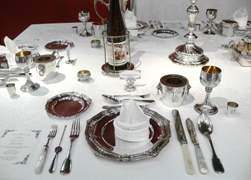
|
Table setting of the 19th century
(from Wikipedia, the free encyclopedia)
CAULDRON SALT CELLARS
The description of the salt cellars we will deal with
clearly illustrates that the cauldron shape remained indeed very
popular during several centuries. The decoration, however, evolved
with the subsequent styles and changed from plain to sometimes
very elaborate decoration.
In the mid 18th century a silversmith particularly renowned as being a
specialist salt cellar maker was Edward Wood of London.
During the reign of Queen Victoria (1837-1901) thousands of salt
cellars were produced. Over-decoration was a characteristic for
the Victorian period and it was not uncommon for silversmiths
to recycle familiar shapes by adding more elaborate chasing.
A sterling Silver Salt Cellar - London, 1746
An early Georgian (George II
(note 2)) sterling
silver, open cauldron salt cellar or open master salt, made in
London, England in 1746 by Edward Wood. The round Rococo
(note 3) style salt
cellar is raised on three hoofed feet with layered shoulders.
The circumference is embellished with repousse work of roses and
leaves. The salt cellar lacks the inner gilding, and a small
pinhole, due to over polishing, is present in the center of a
rose. It measures 69 mm in diameter, stands 39 mm tall and
weighs 52 grams.
The bottom is hallmarked with the lion passant guardant
(note 4) for
sterling silver, crowned leopard's head for the Guild mark of
London and date letter "l" in old English showing that it was
hallmarked in London, 1746. The salt cellar is engraved on the
bottom with the initials D over G.M.
The sponsor’s mark "EW with a crown
(note 5) above and
a crescent below" punched on the bottom is that of
Edward Wood (no relation to Samuel Wood, master to David Hennell). He
is registered as being a specialist salt cellar maker. A research paper
made about him states "no one in London in the mid 18th
century made more salt cellars" (Grimwade, London
Goldsmiths 1697-1837: Their marks and Lives, page 709). This mark
of Edward Wood was entered in 1740, while an earlier mark was
entered in 1722. He died 1752.

|


|
Edward Wood (mark
entered 1722)
|
Edward Wood (mark
entered 1740)
|
Sterling Silver Salt Cellar - London, 1774
A Georgian (George III
(note 6)), sterling
silver, open cauldron salt cellar or open master salt, made in
London, England in 1774 by the renowned silversmiths Nathaniel
Appleton & Ann Smith.
Despite the fact that the salt cellar dates to the
Neoclassical (note 7)
style period it appears that it is executed in the earlier Rococo
style (note 8). The
circumference is embellished with repousse work of roses and
leaves. The round salt cellar has a reeded and rolled edge and
is raised on three elegant hoofed feet with layered shoulders.
It shows no gilding inside.
The salt cellar measures 70 mm in diameter, stands 37 mm tall,
and weighs 54 grams.
The bottom is hallmarked with the lion passant guardant for
sterling silver, crowned leopard's head for the Guild mark of
London and the date letter "T" (in old English) showing that it
was hallmarked in London in 1774.
The sponsor’s mark, "N over A.S over A in a cross", (entered
1771) is also punched on the bottom and stands for the
silversmiths Nathaniel Appleton & Ann Smith
(note 9).
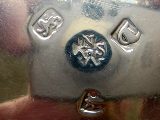
|

|
|
George III
|
Remark: These salts, of 1746 and 1774, were bought as a pair.
Apparently the original owner ordered the silversmiths Nathaniel
Appleton & Ann Smith to copy the design of the salt cellar
dating from 1746.
A pair of Cauldron Silver Salts - London, 1872
A fine pair of Victorian English, sterling silver, cauldron
salt cellars with matching spoons and blue glass liners, made in
London, 1872 by silversmith Robert Harper
(note 10) in his
workshops at 17 Red Lion Street, Clerkenwell.
The salt cellars are raised on three hoofed feet with layered
shoulders. The body is decorated with engraved dots and lines,
three vacant oval cartouches, and a beaded rim. The interior
gilding is still in perfect condition.
Each salt cellar measures 57 mm in diameter, stands 31 mm tall
and weighs 48 grams (69,5 grams liner included).
The bottom is fully hallmarked with the lion passant for
sterling silver, leopard's head for London Assay Office, date
letter "r" for 1872, duty mark "queen's head facing left" and
sponsor's mark "RH in two conjoining circles", entered in
1856, standing for silversmith Robert Harper.
The matching sterling silver salt spoons are decorated with a
beaded design running from the end of the stem to the
round gilded bowl. Each is hallmarked on the reverse of the bowl
with the lion passant for sterling silver, leopard’s head for
London Assay Office, date letter "r" for 1872, duty mark "queen’s
head facing left" and sponsor's mark "RH in two conjoining
circles" standing for Robert Harper.
The spoons are 69 mm long and weigh 7,5 grams each.
In total the combined silver weight of both salt cellars and
spoons is 111 grams.
A pair of Cauldron Silver Salts - Sheffield, 1878
A pair of Victorian sterling silver, cauldron shaped, salt
cellars made in Sheffield in 1878 by the well-known manufacturing firm of the
silversmiths Richard Martin & Ebenezer Hall of Martin, Hall & Co
Ltd.
The salt cellars are adorned with a beaded rim and are raised on
three hoofed feet with layered shoulders. The interior gilding
is still in perfect condition.
Each salt cellar weighs 29,5 grams. They both stand at 25 mm
high and measure 49 mm in diameter.
The hallmarks and sponsor’s mark on the bottom are very clear,
well struck, and read, lion passant for sterling silver
guarantee, crown for Sheffield assay office, date letter "L" for
the year 1878, queen's head facing left proving that duty was
paid, and the sponsor's mark, "RM over EH in a quatrefoil",
standing for Richard Martin & Ebenezer Hall (mark entered June
1863) (note 11).
Both salts are punched on the bottom with the number "6601".
A silver Cruet Set - Birmingham, 1934
A Georgian style, solid sterling silver cruet set
consisting of an open cauldron salt cellar and a pepper pot or
pepper caster, made in Birmingham in 1934 by the silversmith S.
Lambourne.
The large, circular, open cauldron salt cellar with its
original cobalt blue glass liner has a plain smooth shape, a
bowed rim and is raised on three shell capped hoofed feet.
The salt cellar measures 62 mm in diameter, stands 37,5 mm tall
and weighs 60 grams (94 grams including liner).
The bottom is fully hallmarked in a group as assayed at the
Birmingham office with the anchor and date letter "K" for 1934.
The lion passant mark proves it is sterling silver. In the
center, an optional commemorative "Silver Jubilee mark with
the king's and queen's heads facing left"(note
12) is present. The sponsor’s mark "SL in two
conjoining circles" on the bottom is that of S.
Lambourne, jeweller at 158 Hockly Park Road, Birmingham.
ENDNOTES
1 A salt cellar is also known as a salt, an open salt, a salt
dish or a salt dip
2 George II (10 November 1683-25 October 1760) was
King of Great Britain and Ireland, Duke of Brunswick-Lüneburg
and Archtreasurer and Prince-Elector of the Holy Roman Empire
from 11 June 1727 until his death. He was the last British
monarch to have been born outside Great Britain, and was famous
for his numerous conflicts with his father and, subsequently,
with his son. As King, he exercised little control over policy
in his early reign, the government instead being controlled by
Great Britain’s first de facto Prime Minister, Sir Robert
Walpole. (Wikipedia, the free encyclopedia)
3 The rococo style was characterized by the emphasis it gave to
decoration (floral motifs, masks, shells) and was introduced in France by the architect and
goldsmith Juste-Auréle Meissonier around 1720. Its introduction in England dates since 1730
and was completely abandoned in 1765.
4 The walking lion looking to the left over his
shoulder was used during the pre 1822 period
5 A crown above the initials, though not compulsory,
denotes a Royal silversmith
6 George III (4 June 1738-29 January 1820) was king of
Great Britain and king of Ireland from 25 October 1760 until 1
January 1801, and thereafter of the United Kingdom of Great
Britain and Ireland. He was concurrently Duke of
Brunswick-Lüneburg, and thus Elector (and later king) of Hanover.
He was the third British monarch of the House of Hanover and the
first of Hanover born in Britain and speak English as his
first language. George III’s long reign was marked by a series
of military conflicts. Early in his reign, Great Britain
defeated France in the Seven Year’s War, becoming the dominant
power in North America and India. Many of its American colonies
were soon lost in the American Revolutionary War, which led to
the establishment of the United States. Later the kingdom became
involved in a series of wars against revolutionary and
Napoleonic France, which finally concluded in the defeat of
Napoleon in 1815. In addition, during George’s reign the realms
of Great Britain and Ireland were joined, forming the United
Kingdom. Later in his reign, George III suffered from mental
illness and from 1810 his eldest son, Prince of Wales, ruled as
Prince Regent. On George III’s death the Prince of Wales
succeeded his father as George IV. (Wikipedia, the free
encyclopedia)
7 The Neoclassical style (c1755-1805) introduced
decoration based on artifacts from Ancient Greece and Rome
8 The rococo style was characterized by the emphasis it gave to
decoration (floral motifs, masks, shells) and was introduced in France by the architect and
goldsmith Juste-Auréle Meissonier around 1720. Its introduction in England dates since 1730
and was completely abandoned in 1765.
9 Nathaniel Appleton was the son of George Appleton.
He was apprenticed to James Waters in 1751 and became a Freeman in
1759. He entered his mark in partnership with Anne Smith on 26
July 1771. Both silversmiths, Nathaniel Appleton & Ann Smith, were
prolific makers of cream jugs and salt cellars
10 This firm of manufacturing silversmiths was
established c.1853 by Robert Harper who is first recorded at 10
St. John Street Road, Clerkenwell, before moving on 14 May 1853
to 35 Whiskin Street, Clerkenwell. Then on 4 October 1859 he is
recorded at 3 James Street, Goswell Road, EC. Robert Harper is
then recorded at 16 (later 17) Red Lion Street, Clerkenwell, EC
(9.1.1868-2.8.1883). The proprietors, Robert Harper and John
Robert Harper, described as manufacturing silversmiths,
dissolved their partnership on 1 December 1880. Robert Harper,
who still appears to have been a member of the firm, was
adjudged bankrupt early in 1883. Afterwards the business
continued under the style of Robert Harper & Co represented by
John Robert Harper who is recorded on 21 February 1884 at 17 Red
Lion Street, Clerkenwell, EC. The other partners were Joseph
Harper, George Augustus Peacock and Ralph Francis Close.
Following John Robert Harper’s retirement on 2 July 1884,
Joseph Harper, recorded at the same address, entered the firm’s
last mark on 6 January 1885. G.A. Peacock retired on 26
November 1884. Robert Harper & Co is last listed in 1889.
(The Directory of Gold & Silversmiths, Jewellers &
Allied Traders 1838-1914, by John Culme, page 211)
11 Ebenezer Hall started his apprenticeship in 1836 at
the silver plater's firm of John Roberts and became partner in
1846, after which the firm was styled Roberts & Hall with a
factory at Shrewsbury Works, Broad Street Park, Sheffield and
showrooms at Bouverie Street, Fleet Street, London. Roberts and
Hall were joined in partnership by Richard Martin in 1854 to
form the new firm Martin, Hall & Co. John Roberts retired in
1857 and in 1866 the business was converted into a limited
liability company under the style of Martin, Hall & Co Ltd with
Richard Martin and Ebenezer Hall as the first directors. New
branches were opened in Birmingham, Glasgow and Sydney,
Australia.
Following the first World War, the fortunes of the company began
to flag and subsequently went into liquidation and was struck off
the register on 16 October 1936.
(The Directory of Gold & Silversmiths, Jewellers &
Traders 1838-1914 by John Culme, pages 316-317)
12 Commemoration of the Silver Jubilee of King George
V and Queen Mary in 1935. The Silver Jubilee mark was only used
during the years 1934 and 1935.
|
Robert Massart
- 2010 -
|
|
 ASSOCIATION OF SMALL COLLECTORS OF ANTIQUE SILVER
ASSOCIATION OF SMALL COLLECTORS OF ANTIQUE SILVER
